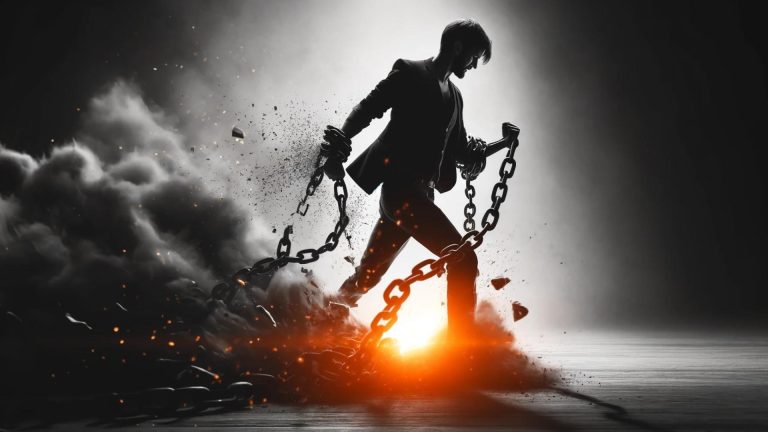Introduction: The Weight of Indecision
Have you ever stood in the cereal aisle, overwhelmed by the sheer number of choices? It’s a simple decision, yet it feels monumental. This everyday scenario illustrates the paralyzing power of indecision. It’s not just about choosing breakfast; it’s a reflection of how we handle—or fail to handle—decisions in our lives. The weight of indecision can be stifling, leaving us stuck and frustrated. But why do we hesitate so much?
Indecision, simply put, is the inability to make a decision. It creeps into our daily routines, impacting everything from minor choices like what to wear, to major life decisions such as career moves or relationships. This hesitation can stem from fear, uncertainty, or a desire for perfection. Understanding the roots of indecision is crucial for breaking free from its grasp.
Recognizing and addressing indecision is essential for personal growth and mental well-being. When we constantly second-guess ourselves, we waste precious time and energy, leading to stress and anxiety. By delving into the causes and effects of indecision, we can develop strategies to overcome it, making our lives more streamlined and fulfilling. Let’s explore the depths of indecision and discover how to conquer this pervasive obstacle.
Table of Content
- Introduction: The Weight of Indecision
- Defining Indecision: What is Indecision?
- Psychological Triggers: Common Causes of Indecision
- Emotional Impact: How Indecision Affects Us
- Real-Life Examples: Stories of Paralyzing Indecision
- Overcoming Indecision: Strategies to Break Free
- Conclusion: Summarizing the Journey
- Frequently Asked Questions
Defining Indecision: What is Indecision?
The Psychological Definition of Indecision
Indecision is more than just a moment of hesitation; it’s a complex psychological state. Psychologists define it as the chronic inability to make decisions, often rooted in deeper cognitive and emotional factors. This state can be paralyzing, leading to feelings of frustration and helplessness. When faced with a choice, individuals may feel overwhelmed by potential outcomes, each carrying its own set of perceived risks and rewards. This overwhelming sensation often causes them to freeze, unable to move forward with any decision.
Furthermore, the psychological perspective of indecision delves into the cognitive processes involved. Our brains are wired to assess risks and benefits, but for some, this process becomes overactive. They dwell on potential negative outcomes, magnifying their fears and doubts. This excessive rumination creates a loop of anxiety and hesitation, making even simple decisions feel insurmountable. Understanding this psychological aspect is the first step in breaking the cycle of indecision.
Different Types of Indecisiveness
Indecisiveness isn’t a one-size-fits-all phenomenon. It manifests in various forms, each with unique characteristics. Some people experience chronic indecisiveness, struggling with every decision, big or small. This type often stems from deep-seated anxiety or perfectionism, where the fear of making the wrong choice overshadows the ability to choose at all. Others may face situational indecisiveness, where specific circumstances or high-stakes decisions trigger their hesitation.
Categorizing these types helps in addressing them effectively. For instance, chronic indecisiveness might require long-term strategies such as cognitive-behavioral therapy to manage anxiety and build decision-making confidence. Situational indecisiveness, on the other hand, can often be managed with short-term techniques like setting deadlines or using decision-making frameworks. Recognizing the type of indecisiveness you experience is crucial for applying the right solutions and overcoming this debilitating habit.

Psychological Triggers: Common Causes of Indecision
Fear and Anxiety in Decisions
Fear and anxiety are significant contributors to indecision. When faced with choices, the fear of making the wrong decision can be overwhelming. This fear often stems from a desire to avoid negative outcomes or criticism. For some, past experiences of failure amplify this anxiety, making it difficult to trust their judgment. They become trapped in a cycle of fear, where every decision feels like a potential disaster waiting to happen.
Anxiety exacerbates this issue by clouding judgment and increasing hesitation. The anxious mind tends to focus on worst-case scenarios, which can make any option seem fraught with danger. This heightened sense of risk makes it nearly impossible to commit to a choice, resulting in a state of paralysis. Understanding how fear and anxiety influence decision-making is crucial for developing strategies to combat these emotions and make more confident decisions.
Analysis Paralysis and Overthinking
Analysis paralysis is a common phenomenon where overthinking leads to decision-making difficulties. When faced with a decision, some individuals get caught up in analyzing every possible outcome, weighing pros and cons to an extreme degree. This excessive scrutiny can be debilitating, as the mind becomes bogged down by details and potential consequences, leaving no clear path forward. The result is a state of paralysis where no decision is made at all.
Overthinking further complicates this process by creating a feedback loop of doubt and second-guessing. Each potential decision is re-evaluated multiple times, often with no new information to justify the prolonged deliberation. This mental exhaustion can lead to frustration and a sense of being stuck, as the decision-making process drags on indefinitely. Learning to recognize and break free from analysis paralysis is essential for overcoming indecision and making timely, effective
Related Article:
Emotional Impact: How Indecision Affects Us
The Emotional Toll of Hesitation
Chronic indecision can take a significant emotional toll on individuals. When we constantly struggle to make decisions, it can lead to feelings of frustration and self-doubt. Over time, these emotions can erode our self-esteem, making it even more difficult to trust our judgment. The persistent inability to decide can also foster a sense of helplessness, as we feel trapped in a loop of endless deliberation with no resolution in sight.
This emotional strain can manifest in various ways, including irritability, mood swings, and even depression. The constant second-guessing and fear of making the wrong choice can be mentally exhausting, leaving individuals feeling drained and overwhelmed. Addressing the emotional aspects of indecision is crucial for breaking this cycle and restoring a sense of control and confidence in our decision-making abilities.
Stress and Anxiety from Indecision
Indecision is closely linked to stress and anxiety. The constant pressure to make the “right” choice can create a significant amount of stress, especially when decisions have far-reaching consequences. This stress can seep into other areas of life, affecting overall well-being and leading to physical symptoms such as headaches, fatigue, and sleep disturbances.
Anxiety further complicates the picture by magnifying the fear of making the wrong decision. It can cause individuals to overanalyze every possible outcome, creating a paralyzing sense of uncertainty. This heightened state of anxiety can make it nearly impossible to make even simple decisions, perpetuating a vicious cycle of indecision and stress. Understanding this link is vital for developing strategies to manage stress and reduce anxiety, thereby improving decision-making capabilities.

Real-Life Examples: Stories of Paralyzing Indecision
Case Study: Career Indecision
Career choices are among the most significant decisions we face, and indecision in this area can have profound impacts. Consider the case of Emily, a talented professional with multiple job offers. Her inability to choose between them led to months of anxiety and missed opportunities. Emily’s fear of making the wrong career move paralyzed her, causing her to remain in a job she was unhappy with.
This kind of career indecision can lead to stagnant growth and dissatisfaction. It prevents individuals from seizing new opportunities and achieving their full potential. By examining Emily’s experience, we can learn about the common pitfalls of career indecision and explore strategies to overcome them, such as setting clear career goals and seeking mentorship.
Case Study: Relationship Decisions
Indecision within personal relationships can be equally paralyzing. Take John, who struggled for years to decide whether to propose to his long-term girlfriend. His fear of making the wrong decision and potential future regrets kept him in a state of limbo, causing strain in their relationship. This prolonged indecision led to feelings of resentment and uncertainty for both partners.
John’s story highlights how indecision can damage relationships by fostering doubt and insecurity. It emphasizes the importance of open communication and trust in making relationship decisions. By understanding the impact of indecision on personal connections, we can better navigate these situations and make more confident choices that strengthen our relationships.
Overcoming Indecision: Strategies to Break Free
Building Confidence in Decision Making
Building confidence is crucial for overcoming indecision. One effective technique is to start with small decisions to gradually build trust in your judgment. Celebrating these small victories can boost self-esteem and create a positive feedback loop, encouraging more decisive behavior. Additionally, practicing self-compassion and acknowledging that not every decision needs to be perfect can reduce the pressure to always choose correctly.
Another approach is to visualize positive outcomes. By focusing on potential successes rather than failures, you can shift your mindset towards a more optimistic and confident outlook. This mental shift can reduce the fear associated with decision-making and help you approach choices with greater assurance. Confidence in decision-making grows with practice and a conscious effort to trust oneself.
Practical Tools to Make Decisions
Using practical tools can significantly aid in effective decision-making. Decision matrices, for example, allow you to weigh the pros and cons of each option systematically. By assigning values to different factors, you can objectively evaluate which choice aligns best with your priorities and goals. This method reduces the emotional weight of decision-making and provides a clear path forward.
Another useful tool is the “five-second rule,” which encourages you to make a decision within five seconds of identifying it. This technique combats overthinking and prompts immediate action, reducing the time spent in indecision. Additionally, setting deadlines for decisions can help prevent prolonged deliberation. By implementing these practical tools, you can streamline your decision-making process and overcome the paralyzing effects of indecision.

Conclusion: Summarizing the Journey
Indecision, while seemingly benign, can have profound impacts on our daily lives and overall well-being. Recognizing its psychological roots and emotional toll is the first step towards overcoming it. By understanding why we hesitate, we can begin to address the fears and anxieties that hold us back. This awareness is crucial for breaking free from the paralyzing grip of indecision and moving forward with confidence.
The real-life examples of career and relationship indecision illustrate how hesitation can stifle growth and strain personal connections. Learning from these stories provides valuable insights into the common pitfalls and effective strategies for overcoming indecision. Whether it’s making a major life choice or navigating everyday decisions, these lessons highlight the importance of decisive action and clear thinking.
Ultimately, building confidence and utilizing practical tools can transform our approach to decision-making. By practicing small, confident choices and employing methods like decision matrices and the five-second rule, we can streamline our decision-making processes and reduce the stress and anxiety associated with indecision. Embracing a decisive mindset not only enhances our personal and professional lives but also empowers us to face challenges head-on, turning hesitation into action and uncertainty into clarity.
FAQs on Indecision
What are the main causes of indecision?
Indecision often stems from fear of failure, perfectionism, and overthinking. Psychological factors such as anxiety and low self-esteem also play significant roles. Understanding these causes can help in addressing and overcoming the hesitation that paralyzes our decision-making processes.
How can I overcome indecision in my daily life?
Overcoming indecision involves building confidence, setting clear goals, and using practical tools like decision matrices. Start with small decisions to build momentum and practice the five-second rule to combat overthinking. Consistent practice of these techniques can significantly improve decisiveness.
Why is indecision harmful?
Indecision can lead to stress, anxiety, and missed opportunities. It wastes time and mental energy, creating a sense of frustration and helplessness. Over time, chronic indecision can erode self-esteem and negatively impact personal and professional growth.
What techniques help in making quick decisions?
Effective techniques for quick decision-making include the five-second rule, decision matrices, and setting deadlines. These methods streamline the decision-making process, reduce overthinking, and encourage immediate action, helping to overcome the paralysis caused by indecision.
Can indecision affect mental health?
Yes, indecision can significantly affect mental health. Chronic hesitation leads to increased stress and anxiety, which can result in emotional exhaustion and depressive symptoms. Addressing the root causes of indecision is crucial for maintaining mental well-being and overall life satisfaction.
